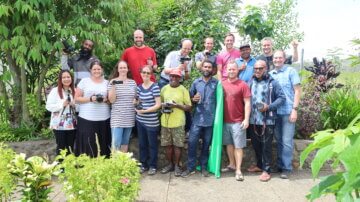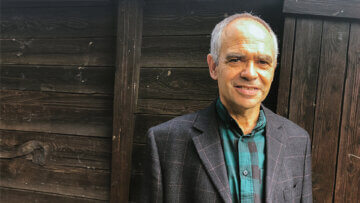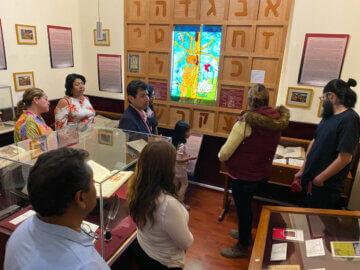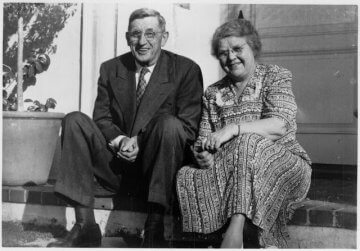Beginning of a Movement
Synopsis
In the 1920s, Wycliffe Bible Translator’s co-founder, William Cameron Townsend, began to recognize that the needs of indigenous people groups differed significantly from those of their surrounding cultures. This shaped his vision that every people group should have the Scriptures in their own language.
Townsend oversaw the first Camp Wycliffe in 1934. This course prepared linguists and translators for field work. It was later called the Summer Institute of Linguistics (SIL) because it was, at that time, held only in the summer months. A scientific linguistic organization, SIL served among minority linguistic groups in many countries.
In 1942, Wycliffe Bible Translators Inc. was formed, to oversee fundraising and recruitment of personnel for SIL. Wycliffe represented the needs (people, prayer and finances) to the Christian public, while also presenting the vision of Scriptures being available in the languages of all peoples. Townsend believed that the two interdependent organizations each had a unique role to fill.
A new type of organization began to emerge in 1973, initially referred to as ‘National Bible Translation Organizations.’ They emerged as a consequence of missiological changes in the growth of the Church in the global South and East. SIL supported their formation, and provided training. These organizations sponsored linguistic studies, literacy and Bible translation in their own countries. They engaged with the local church, promoted mother-tongue Scripture use, and recruited mother-tongue translators, personnel and prayer support for Bible translation work, effectively carrying out Wycliffe-type functions in their own countries.
The original strategy of Wycliffe organizations gathering resources for SIL to do fieldwork had shifted. As the Church was finding new homes in the global South and East, and resources from the West decreased, Wycliffe began a journey of redefining its place in the global context, as well as its intertwined relationship with SIL.
Read the full article below.
Full Article: Article 2 – Beginning of a Movement
Introduction
As mentioned in the introductory article, Wycliffe Bible Translators started in 1942 as a resourcing organization for the Summer Institute of Linguistics (now called SIL International). While these two organizations had a common beginning, the last two decades have fundamentally redefined both organizations, but especially Wycliffe. Its character has been shaped by the changing dynamics of the global church.
The past seven decades of changes in church and mission agencies across the world include structural challenges for Wycliffe Bible Translators and SIL.
The Beginning – 1914-1933
William Cameron Townsend, Wycliffe’s founder, was not the kind of person one might have imagined for such a task. As one of Townsend’s biographers, William Svelmoe observes, Townsend was “not the typical evangelical Bible institute graduate burning with a long and zealously nurtured passion for the lost heathen” (2008:1). Nevertheless, the agencies he birthed have outlived him by more than 30 years and show no signs of ending.
Townsend’s parents had moved to California from the East coast of the U.S. in 1893 in search of a better life and to find relief from poverty. Townsend was born three years later and was eventually joined by five siblings. His industrious father committed himself to raise his family as fundamentalist Christians (Svelmoe 2008:3).
In 1914, Townsend chose to attend Occidental College in greater Los Angeles. It had Presbyterian roots but made no claim to be a Bible institute. At the college Townsend attended Student Volunteer Movement (SVM) meetings that made him restless because he was fascinated by the students’ stories about their jaunts in overseas cross-cultural mission. This became the primary influence on Townsend’s desire to experience something of the world beyond California. This quest for something new stirred Townsend, now just 21 years old, to board a ship headed for Guatemala in September 1917.
The SVM, along with the Young Men’s Christian Association (YMCA), had played a major role in broadening Townsend’s horizons. While both groups were criticized by fundamentalist Christians as succumbing to post World War 1 liberal theological influences in the U.S., these two institutions did not seem to shape Townsend’s theology of mission.
Townsend himself admitted he was not a serious student of missions. He had read a pamphlet and the biography of David Livingstone, but that was about it (Svelmoe 2008:8). However, Townsend did believe he was obligated to go to Guatemala. He understood that he was obeying a calling from God and that was all that mattered. He felt so strongly about this that he suspended his undergraduate studies with only a year to finish.
Townsend felt led to serve with the Bible House, a publisher of Spanish-language Bible portions and gospel tracts. Upon arrival in Guatemala he became a colporteur (a person who sells or distributes books) and handed out tracts and Scripture portions in Spanish to anyone he met who would accept his gifts.
He was looked after by missionaries and administrators of the Central America Mission (CAM) – an arrangement negotiated by the Bible House. Young Townsend thought of these people as spiritual giants in his life.
Townsend had no formal cross-cultural missionary training and spoke only minimal Spanish that he learned in high school. His knowledge of the Bible was learned at church and from his parents. Svelmoe explains Townsend’s lack of training by today’s standards: “Years of college and seminary were not required to tell the simple gospel story to souls perceived as lost. Linguistic and anthropological training was therefore virtually nonexistent for prospective missionaries” (2009:630).
Diaz helped Townsend see that the needs of the indigenous Cakchiquel were very different to that of the Latinos. This was an important insight for Townsend.
Francisco Diaz, a Cakchiquel about 35 years of age, who had recently given his life to Jesus, was paired with Townsend to help him sell Spanish Bibles and tracts. Diaz helped Townsend see that the needs of the indigenous Cakchiquel were very different to that of the Ladinos. This was an important insight for Townsend since his focus had been limited to Spanish language literature and Bibles.
Diaz, with Townsend’s help, soon started a school for Cakchiquel children. About this time Townsend met a fellow missionary named Elvira, and after marriage they settled at the school Townsend and Diaz had started. The friendship with Diaz came to an untimely end when Diaz died of malaria in 1920.
He discovered essential principles about communicating in the vernacular language. This and the influence of Diaz shaped his vision that every language group should have the Scriptures in their own language.
These first three years (1917-20) in Guatemala made Townsend realize the importance of the Cakchiquel language community and their unique identity. He discovered essential principles about communicating in their vernacular language. This and the influence of Diaz shaped his vision that every language group should have the Scriptures in their own language.
Townsend’s growing interest in the indigenous peoples and their native languages strained his relationship with CAM. The mission, at that time, was more interested in ministry to the Ladinos. But Townsend’s concern for the indigenous people would not go away.
In January 1921, Townsend and eleven other missionaries serving in Guatemala gathered for the General Indian Conference. They nicknamed themselves the ‘Chichicastenago Twelve’ after the town where they met. The focus of their conference was on the indigenous – the ethnic minorities of Guatemala and nearby countries – because they had received little attention from the mission agencies in the region (Steven 1995:40). The concerns of these agencies was more aligned with long established agencies such as the British and Foreign Bible Society that focused on making the Bible available in major languages of the world.
Townsend and his like-minded Chichicastenago Twelve felt the pressing need to help the Indians find Christ through their own language and culture rather than having to do so through the Spanish language and Ladino culture. This concern became the seed for Townsend’s burden and vision to help minority language groups.
Meanwhile Townsend and Elvira proceeded with translating the New Testament into Cakchiquel. It was dedicated on 10 October 1929 at the First Presbyterian Church of Santa Ana, California. The momentous work came with great misunderstanding because Ladino missionaries amongst the Cakchiquel preferred to use Spanish and seemed threatened by the fact that the Cakchiquel people now had the Scriptures in their own language (Steven 1995:199).
After 15 years serving in Guatemala Townsend returned to the U.S. unsure about what he would do next. He felt a burden to help other indigenous communities in Central America. At the urging of his friend L.L. Legters, the two attempted to cross the border of Texas into Mexico to explore potential work there. However, the border officials put a stop to their entry stating that Protestant missionaries were not welcome in Mexico.
Attempts at a New Strategy – 1934-1941
Being refused entry into Mexico was a turning point that caused Townsend (the visionary) and Legters (the implementer) to found Camp Wycliffe in the summer of 1934. The purpose of the seven week camp was to train ‘pioneer’ missionaries with a particular focus on linguistics and Bible translation. The camp was held at an unfurnished rural farm house near Sulphur Springs, Arkansas. This simple environment helped the students learn basic survival skills that Townsend thought would be similar to what they would experience in the remote jungle areas where he wanted to send them (Stevens 1999:1). Three students sat under the instruction of Townsend, assisted by Cakchiquel speaker José Chicol. They used linguistic theory formulated from Townsend’s experience with the Cakchiquel language.
This was not a good time to try to start something new as it was the era of the Great Depression in the U.S. But this did not deter the faith of Townsend or Legters. In fact it was a pattern that Townsend became known for – trusting God for the impossible. It is worth noting that this theological foundation continues as a core value of the Wycliffe Global Alliance, stated as: “We depend on God and his sufficiency to equip and sustain for life and mission” (WBTI 2008:13).
It was a pattern that Townsend became known for – trusting God for the impossible.
Townsend returned to Arkansas in 1935 to hold the second Camp Wycliffe. This time there were five students and the subjects increased to include phonetics (the discovery, study and writing of previously unwritten and studying unknown sounds in a language).
As soon as the course was finished, Townsend, Elvira and several of the students put into practice what they had learned at Camp Wycliffe by going to an Aztec village near Mexico City. Within a short time Townsend’s work attracted the interest and support of key Mexican government officials. This too became characteristic of his mode of operating – building good relationships with leaders at all levels of a host government.
This too became characteristic of his mode of operating – building good relationships with leaders at all levels of a host government.
Townsend’s relationship with CAM had been deteriorating for many years due to its focus on Ladino ministry and because Townsend’s priority for Indian evangelism included Bible translation. It was only a matter of time before it would become an unworkable relationship. Not wanting to set up his own agency, Townsend found a new partner for his vision – the Pioneer Mission Agency (PMA) of Philadelphia, a small mission willing to provide U.S. sponsorship for his work.
Wycliffe Bible Translators is Born – 1942-1944
After the first Camp Wycliffe, Legters remained in the U.S. to raise funds and promote Townsend’s work in Mexico. Eventually, as more people took the training and went to Mexico, PMA decided they could no longer provide sponsorship for these two men.
In response to the PMA decision, Townsend formed two distinct organizations. The first was the Summer Institute of Linguistics in 1934. Initially, it provided the strategy and structure needed to place newly trained linguist-Bible translators in Mexico (and later other countries in South America, followed by Asia, the Pacific and Africa). The name was based on what the Camp Wycliffe courses became – an institute for linguistic training held in the summer months. The same organization also conducted the field work.
It took another eight years before there was any formal organization in the U.S. that did the fundraising and recruitment of personnel for SIL.
In 1942 Wycliffe Bible Translators Inc. was formed with its headquarters in the small garage apartment in Southern California belonging to Townsend’s friend, Bill Nyman. Nyman was a businessman and served as a volunteer for Wycliffe. The funds that came into this little office were sent directly to the SIL field locations, although the Wycliffe office took five percent of the funds to pay for a secretary’s salary and office supplies.
When Nyman and Townsend discussed names for the new organization they considered ones such as ‘Pioneer Translation Agency’ and ‘Bible Translation Movement’ but settled on Wycliffe Bible Translators (WBT) instead (Svelmoe 2008:295).
Various interpretations of this era impacted how the Christian public, the non-Christian world and those involved with either organization understood the unique relationship between the two organizations. Townsend was candid with his supporters in his explanation of this relationship. He was adamant that, despite any confusion, both organizations had unique roles to fill and were interdependent with each other.
Townsend regularly needed to clarify to those within and outside of SIL and Wycliffe the dual nature of these two organizations.
Townsend regularly needed to clarify to those within and outside of SIL and Wycliffe the dual nature of these two organizations. They were often referred to with two names for the same organization even written as ‘Wycliffe/SIL’ or ‘SIL/WBT’. SIL was according to Townsend, a scientific linguistic organization that served in research among minority linguistic groups in many countries and that those carrying out this task were motivated Christians who wanted to see the Christian Scriptures available in these languages. SIL also conducted academic courses initially in the summer at universities, originally in the U.S. Wycliffe, according to Townsend, represented the needs (people, prayer and finances) of this vision to the Christian public.
With the increase of personnel going to the field to work with SIL, the Wycliffe office eventually moved into larger facilities at Huntington Beach, California. By then Wycliffe was not only meeting the needs of teams serving under SIL in Latin America, but it was also actively promoting the needs and work of Bible translation to the U.S. church.
In 1944 Elvira Townsend died after a long illness. While greatly saddened, Townsend continued his quest to serve the indigenous groups of Latin America. Two years later he met and married a Wycliffe member, Elaine Mielke. A few weeks after their honeymoon they led a group of 20 new recruits into the eastern rain forests of Peru where there were at least 40 indigenous groups that had unwritten languages.
Branching Out – 1945-1970s
In 1944 SIL linguists accepted an invitation to run an SIL training school in Canada with 40 students. This began a trend that continued for the next decade with further introductory linguistics training courses conducted in other countries. In the early 1950s the Interdenominational Missionary Fellowship of Victoria, Australia sponsored the Wycliffe School for Linguistics for Missionaries with Kenneth Pike from SIL as its first Principal. Subsequent courses were held in Australia and England throughout the following years. While the courses served mission organizations that wanted SIL’s expertise in linguistics and language learning, they also created interest among prospective missionaries who were attracted to Bible translation as a new form of cross-cultural ministry.

Wycliffe UK: Whether headed for Amazonia, Africa, Papua New Guinea or beyond, for many the journey began with Wycliffe training in the UK.
By the late 1950s and early 1960s, this increased interest saw the formation of Wycliffe organizations in Canada, Australia and the U.K. Each organization was incorporated within its own country but they were also given formal recognition as subsidiaries of Wycliffe Bible Translators, U.S. and internally they were referred to as ‘Divisions’ of the U.S. office.
The vision for Bible translation in the languages of minority peoples spread elsewhere: New Zealand in 1965 and throughout Europe in the 1970s. European churches began sending out a new workforce through Wycliffe divisions in Germany, Switzerland, the Netherlands, France and Finland.
National Bible Translation Organizations – 1973-1980s
In the early 1970s to the late 1980s, a significant shift occurred that tested the organizational boundaries of SIL and Wycliffe. The 1973 international conference of the two organizations opened the way for new types of organizations to be formed. At the time these were called ‘National Bible Translation Organizations’ (Steven 2004:227). Each of these organizations supposedly developed under the guidance and assistance of both SIL and Wycliffe. However, it was SIL that supported their formation because these organizations also sponsored linguistics, literacy and Bible translation work in their own countries. The agencies also engaged with the church in their countries, serving as promoters for mother-tongue Scripture use and recruiting personnel and prayer support for Bible translation work. In this manner they carried out Wycliffe-type functions in their own countries. Most of their translators, usually trained by SIL, were ‘mother-tongue’ translators meaning that they served in their own language communities.
These national organizations emerged during the missiological shifts in the growth of the Church in the global South and East. They were also part of the spread of nationalism particularly in Africa where independence movements impacted the churches, missions and other not for profit agencies. Increasingly there was the call for local citizens to take greater authority over the affairs of their nations. Over a period of 15 years there emerged national translation organizations in Nigeria, Ghana, Burkina Faso, Cameroon, Kenya, India, the Philippines, Indonesia, Papua New Guinea and Brazil. They had unique names such as Nigeria Bible Translation Trust (NBTT) and the Papua New Guinea Bible Translation Association (BTA).
These organizations created a shift in what had been the simple strategy that Wycliffe organizations raised the resources for SIL to do its fieldwork. Now there were new organizations, essentially birthed by SIL, which had a vision for their own countries. A threshold had been crossed in the relationship between SIL and Wycliffe because there were now others who shared the vision of Bible translation and had functions relating to both organizations.
It is unclear whether Townsend actually supported the emergence of these new national organizations. As they developed he was no longer in active leadership although as founder he still exerted great influence and was respected in both SIL and Wycliffe. In a speech in March 1977 to his staff Townsend encouraged the use of ‘tribesmen’ to do the translating. However, he stated: “Now of course, those [tribesmen] will not become members of Wycliffe Bible Translators, at least not in the foreseeable future” (Hibbard 2007:50). Instead, he said they should be employed by SIL members to do the translating. He did not believe that national translators would eliminate the need to recruit foreigners as the main workers and leaders for Bible translation and other tasks of SIL.
It appears that as long as Townsend was alive, he resisted the idea of having national Christians do the translating and run their own translation organizations.
It appears that as long as Townsend was alive, he resisted the idea of having national Christians do the translating and run their own translation organizations, even if affiliated with SIL and Wycliffe. He believed that the West (mainly the U.S.) would then be neglecting its responsibilities. Biographer Hugh Steven states that Townsend “struggled to incorporate this new paradigm [the national Bible translation organizations] into his thinking” (2004:228). Townsend wrote a prayer about this expressing his fear that the Lord would not look with favour and would think that he had decided to “pass the buck [and] let the nationals do it” (Steven 2004:228). There is some speculation that Townsend held this view until he died in April 1982. He was a man of his times and his thinking, while progressive for his time, was not open to all the possibilities the future could hold or all the plans God intended.
Conclusion
This article began by outlining the humble beginnings of SIL International in 1934 through a man of faith, William Cameron Townsend. Eight years later Wycliffe Bible Translators was formed mainly out of necessity to support the work of SIL. It seemed like more of an afterthought than a leading strategy.
Fifty years later the world had drastically changed and the Church was finding new homes in the global South and East. As the resources from the West decreased, Wycliffe began a journey of redefining its place in the global context, as well as its intertwined relationship with SIL.
The latest
View all articles
03/2024 Pacific: Papua New Guinea
Informing, teaching, inspiring: PNG workshop teaches video storytelling for language communities
PNG workshop teaches video storytelling for language communities
Read more
02/2024 Global
Looking ahead at 2024
As the year unfolds, we marvel at the work of God in our rapidly changing world. And, we look forward to a number of gatherings and conversations intended to draw us together.
Read more
01/2024 Americas
Telling the Bible's Story
It may come as a surprise that a museum is among the Wycliffe Global Alliance organisations.
Read more

